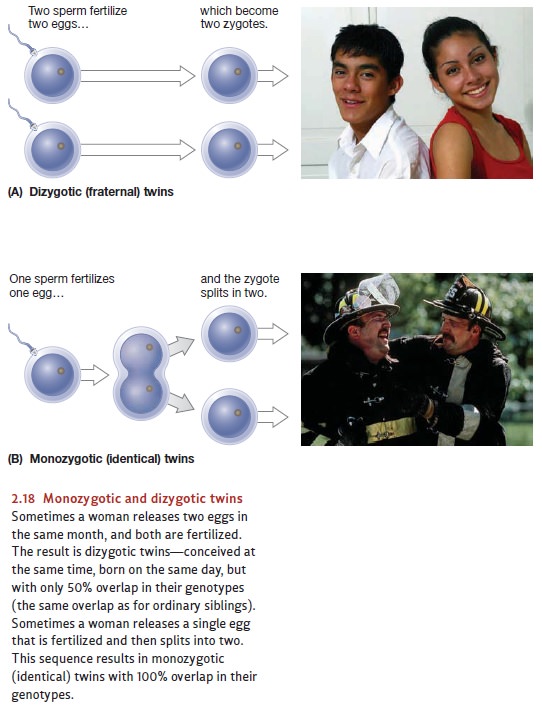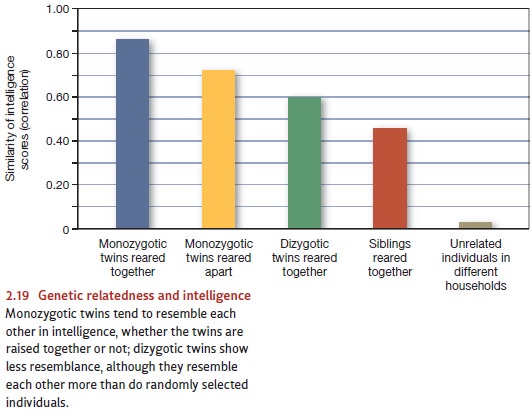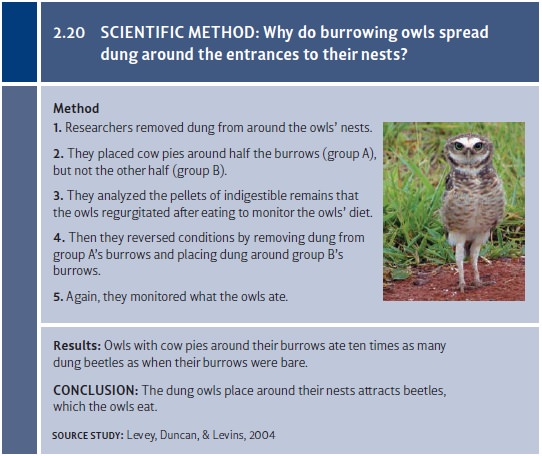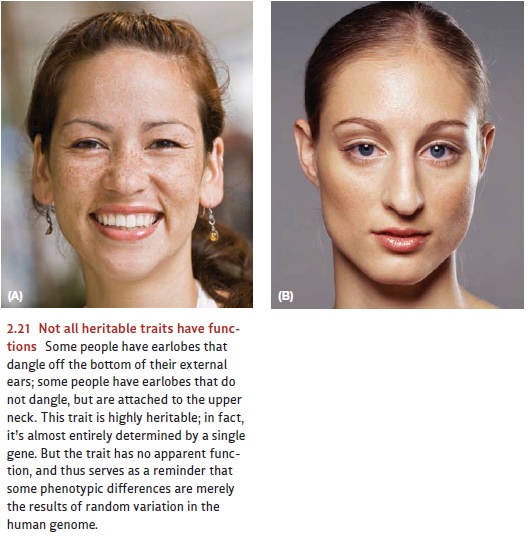Chapter: Psychology: The Genetic and Evolutionary Roots of Behavior
The Genetics of Intelligence
The Genetics of
Intelligence
In our discussion of smiles, we
drew on several types of evidence: observations of indi-viduals in special
circumstances (e.g., people blind since birth) as well as comparisons across
cultures and across species. These various forms of evidence all point toward
the conclusion that smiles have ancient evolutionary roots. But there is
another source of information that’s just as important for inquiries into the
biological roots of a behavior or capacity: a comparison among family members.
This point is well illustrated by the study of the ways in which humans differ
in their levels of intelligence.
Broadly put, intelligence refers to the capacity that allows people to acquire
new knowledge and use it to draw conclusions, solve problems, and adapt to new
circum-stances. Researchers have devised various intelligence tests and found
that people vary considerably in how much of this capacity they have. We need
to acknowledge the considerable debate about these tests (e.g., whether they
are fair to all groups) and about the definition itself (e.g., whether there
are intellectual skills left out of the defi-nition, and thus left out of the
tests). Nonetheless, there are many indications that the tests, refined over
the last century, are valid. For example, the measurements line up well with
our commonsense notions of intelligence (and so people you think of as “smart”
are likely to do well on the measurements). The measurements also allow us to
predict how well people will perform in a range of activities that seem in
obvious ways to require intelligence.
We’ll have more to say about
these issues, but in the meantime we can ask: Where do these measured
differences come from? As is usually the case, the answer has several parts.
For a start, a number of environmental variables influence intelli-gence, and
so (for example) many factors associated with poverty impede intellectual
growth and thus undermine a person’s intellectual potential. Conversely,
lifting someone out of poverty and into a healthier, more enriched environment
can increase intelligence. Moreover (and encouragingly!), spending time in school seems to increase intelligence.
But, in addition, the evidence is clear that these environmental factors
interact with genetic factors that also matter for intelligence. Let’s look at
the evidence.
COMPARISONS AMONG RELATIVES
We mentioned earlier that all
members of a species resemble each other genetically, and this point applies to
humans just as it applies to any other creatures; this is why we all have
bodies of a distinctly human shape, internal organs that are unmistakably
human, and so on. But, even though we have the same human genome, each of us
has our own pattern of alleles for these genes, half inherited from our mother
and half from our father. Because of this legacy, there’s a 50% overlap between
each child’s genetic pattern and the pattern of each parent. By similar logic,
there’s also 50% overlap, on average, between each child’s pattern and the
pattern of his or her biological siblings.
What about twins? Here it’s
crucial to distinguish two types of twins: Typically, a woman releases one egg
per month, and it’s either fertilized or not. Occasionally, the woman releases two eggs in the same month, and each egg
may be fertilized by one of

the father’s sperm. This sequence
of events results in dizygotic twins
(sometimes called DZ or fraternal twins): siblings who are conceived at the
same time, develop in the uterus together, and are born on the same day. But,
just like any other siblings, DZ twins grow from distinct eggs and distinct
sperm cells, and so the genetic relatedness between them is the same as it is
for other siblings—a 50% overlap in the genome (Figure 2.18).
In other cases, the mother
releases just one egg and it is fertilized by one sperm; but then the egg
splits into two, so that a pair of fetuses develop from the same (fertilized)
egg. This results in monozygotic (MZ
or identical) twins. Since both MZ twins developed from the same egg and the
same sperm, they have a 100% overlap in their genomes.
We can attempt to tease out the
influence of genes on intelligence by comparing the similarities between DZ
twins as opposed to MZ twins in intelligence tests. If genes influence test
scores, then the resemblance within monozygotic twin pairs (with 100% overlap
between the patterns of their allelles) should be stronger than the resemblance
within dizygotic twin pairs (50% overlap). For that matter, the resem-blance
within dizygotic pairs should be greater than the resemblance between pairs of
randomly chosen (not related) individuals (who have 0% overlap in the pattern
of their alleles). All of these predictions are correct: Monozygotic twins
resemble each other closely in their intelligence levels, and so the
correlation between their intelligence scores is an impressively high .86. If
we examine pairs of dizygotic twins, we still find resemblance, but less so
than with monozygotic twins; and the correlation between their scores is
roughly .60. And, if we choose individuals at random (no overlap in genome), we
find little resemblance between their scores—often a correlation of zero.
(Figure 2.19).

But there’s a complication in
these data: Monozygotic twins grow up in virtually identical environments.
(After all, people often can’t tell the twins apart, and so of course end up
treating them in the same way!) Dizygotic twins are likely to be treated a bit
differently from each other, but they usually grow up in the same home with the
same parents, the same resources, and the same schooling. If we examine random
individuals, in contrast, they are sure to have grown up in different
envi-ronments—and so they experienced different levels of stimulation,
different types of education, different levels of encouragement by their
parents, and more. Thus, perhaps the pattern in intelligence scores—great
resemblance among monozygotic twins, less among dizygotic twins, less among
random individuals—can be explained without reference to genetics. Perhaps the
data are telling us instead that people who grow up in similar environments tend to end up with similar levels of
intelligence.
Researchers have several ways of addressing
this issue, including the study of children who have been adopted and raised by
adults who are not their biological fore-bears. This situation allows us to
examine the resemblance within pairs of identical twins who were adopted by
different families and so raised in different households. Under these
conditions, we can study the effect of the twins’ shared genetic pattern when
they’re exposed to different environmental influences. Even in this situation,
the resemblance between the monozygotic twins is quite strong.
In the same spirit, we can
compare the intelligence scores of adopted children to the scores of the adults
who raised them, and we can also
compare these scores to those of the children’s biological parents. The data
show a much stronger resemblance between each child and his or her biological
parents than between the child and the adopted parents—another way of showing
the power of genetic factors.
HERIT ABILITY
We noted earlier that various
environmental factors influence intelligence. Some factors (e.g., poverty)
undermine intelligence, and other factors (e.g., schooling) lift it. But the
comparisons among relatives make it clear that intelligence is also shaped by
each person’s genotype; we see this in the fact that individuals who resemble
each other genetically also resemble each other in intelligence scores—even if
they live in different settings.
Is there some way to combine
these findings to ask, in essence, to
what extent genetic factors are responsible for the differences between
individuals, as opposed to the effect of environmental influences? Researchers
usually address this question by asking about variance, a statistic that quantifies variation. More specifically,
researchers computea heritability ratio—a
statistic summarizing how much of the variance in a population can be
attributed to genetic differences among individuals. To compute this ratio,
researchers begin by asking, for a particular trait and a particular population:
How muchphenotypic variance is there in
this group? They then ask: How much
of that phenotypic variance is caused by differences in the genome? These
two numbers are then combinedin a ratio:

This ratio can take a value
between 0 and 1, where 0 indicates that none
of the pheno-typic variability is attributable to the genome, and 1 indicates
that all of the phenotypic
variability is attributable to the genome.
Let’s be very clear that a
heritability estimate tells us only about the causes of vari-ation within the
population studied, and it applies only to the particular environ-ment in which
the population was studied. Indeed, this point is built into the measurement.
We start by asking: How much do the individuals’ phenotypes vary inthe group that we’re examining, in their
current environment? Then we ask: How
much of this variability can be attributed to genetic factors? Unmistakably,
therefore, the measure-ment is defined from the start for a specific group in a
specific environment. The measurement will likely change if we consider a
different group (or the same group in a different environment).
It’s also important to remember
that heritability estimates tell us nothing about the genetic influence on an individual’s traits. As we’ve discussed,
within each individual, the effects of genes and environment are inseparable. A
heritability ratio is a descrip-tion of a group—and
it tells us what proportion of the total variation within that group is attributable
to genetic differences between the group’s members.
Researchers have given various
estimates for the heritability of intelligence; in one study (McClearn,
Johansson, Gerg, Pedersen, Ahem et al., 1997), the estimates ranged from .29 to
.75, suggesting that 29% to 75% of the differences between individuals’ levels
of intelligence are due to genetic differences. Within this range, though, the
most commonly mentioned heritability for intelligence is .60 or about 60%.
The wide range of estimates for
the heritability of intelligence provides a useful reminder that heritability
depends on the group and the environment being consid-ered. To see how
important this is, consider a study that examined intelligence scores in two
groups of people: a group of middle-class individuals and a group of people
with low socioeconomic status (SES) (Turkheimer, Haley, Waldron, D’Onofrio,
& Gottesman, 2003). For the middle-class group, the study estimated the
heritability of intelligence to be roughly 70%. For the low-SES group, in
contrast, the estimated her-itability was close to zero.
Why should this be? One
interpretation is that the human genome provides a poten-tial for developing intellectual skills, but this potential
will emerge only if the personreceives adequate nourishment, decent health
care, and appropriate intellectual stimu-lation. Without these ingredients,
that person’s potential will never be realized—and so the influence of the
genes (which define the potential at the outset) will never become visible. This
may be why, in a low-SES environment, the genes (setting the potential) have a
much weaker effect on intelligence.
As a different example, consider
the effects of age. One might expect
that the heritability of intellectual skill would be higher in young children
than in older individuals because, as time goes by, the person is exposed to
more and more environ-mental influences that can potentially offset or eclipse
the influence of genetic factors. In truth, though, the opposite is the case;
the heritability of many psychological traits—including intelligence, but also
including various measures of personality— tends to increase with age (Bergen, Gardner, & Kendler, 2007). One
likely explanation is that individuals with different genotypes choose different
life experiences; in partic-ular, they may seek out experiences that amplify whatever genetic differences
they started with. As a result, those genetic differences grow more visible as
the years go by (Kendler & Baker, 2007).
THE EVOLUTION OF INTELLIGENCE
We can draw many lessons from our
discussion of intelligence so far. First, we’ve seen the power of some research
tools—such as the comparison of monozygotic and dizy-gotic twins, and the need
to examine both the effects of shared genome and those of shared experience.
Second, we’ve considered an important form of measurement—the heritability
ratio—but also discussed the limitations of that measurement. Third, we’ve once
again seen the importance of the interaction between genes and environment
(this was crucial for the notion, just mentioned, that experience can amplify genetically rooted traits). And,
fourth, we’ve encountered new reminders of the need to distinguish genotype and
phenotype (e.g., the genotype seems to have little impact on the pheno-typic
intelligence of low-SES individuals).
All of these issues speak to the proximate cause of intelligence. What
about the ulti-mate cause? What can we say about the broad evolution of
intelligence? Claims about ultimate cause focus on the function of a trait, asking how the trait might have promoted the
survival and reproductive success of our ancient ancestors. Sometimes, we can
address this issue by considering the function of the trait in the current
environment— how does the trait help us now?
What we need to work toward, however, is an account of the trait’s function in
the environment of evolutionary
adaptiveness (EEA), the environment that was in place when the trait was
evolving. This earlier environment is a key consideration because—as mentioned
earlier—natural selection has no way to peer into the future. The process
depends only on whether an organism’s traits help it to survive and reproduce
in its current environment.
Sometimes the function of a trait
is obvious; sharp claws and camouflage are fairly easy to understand. But often
careful experiments are needed to discern why a particular trait or behavior is
in place. To illustrate this point, let’s step briefly away from the topic of
intelligence and consider the study described in Figure 2.20. Researchers
wanted to find out why burrowing owls engage in the puzzling (and somewhat
bizarre) behavior of collecting animal dung and spreading it around the
entrances to their bur-rows. One possible explanation is that the stench of the
dung around a burrow might repel predators and thereby protect the eggs and
chicks inside. Owls that festoon their burrows with dung would thus see more of
their chicks survive than would owls that prefer a clean front porch. A second
hypothesis is that the owls use the dung as bait to attract the dung beetles
that they eat, and so the owls can feed themselves while contin-uing to guard
their nests. When the researchers tested both claims, they found strong
evidence that owls collect dung because it attracts food. This example shows
that we can often test hypotheses about a behavior by examining the behavior’s
contemporary function, taking care to rule out alternative explanations.

Let’s now return to the topic of
intelligence, and ask: Why did humans evolve to be so smart? We’ve already
mentioned that our ancient ancestors would have benefited from flexibility in
their behavior and from being able to solve problems, detect patterns, and draw
conclusions. It seems likely that these skills would have led to a reproductive
advantage—and, if so, natural selection would have favored individuals with
these skills. The result, over many generations, would be that levels of these
skills would have increased in the population at large.
But why do individuals differ in their level of intelligence?
What’s the ultimate cause of the differences
in intelligence from one person to the next? The answer, in brief, is that we
do not know, and, in thinking about this issue, it’s important to keep in mind
that some of an organism’s traits—including traits significantly influenced by
the genome—may not be a product of natural selection.
To make this point clear, we need
to bear in mind that some traits improve an organ-ism’s chances of surviving
and reproducing; other traits undermine the organism’s chances; and still other
traits don’t matter for survival.
Evolution, of course, will work to promote the first type of (helpful) traits,
and will work to eliminate the second (harm-ful) type. But the forces of
natural selection will have no impact on the third type of traits, and so these
traits will simply remain in place, unaffected by evolution.
As one example, consider the fact
that people differ in whether their earlobes are detached from their heads or
not (Figure 2.21). This variation is clearly rooted in the genes, but it seems
highly unlikely that this trait had any impact on our ancestors’ chances of
surviving and reproducing. As a result, evolution favored neither attached
earlobes nor loose ones, and so both genotypes remained in place for our
species— commonly occurring variations on the human genome.

Of course, there are many
differences between ear lobe shape and intelligence. Among other points,
earlobe shape is governed almost entirely by genetic factors; intel-ligence, in
contrast, depends—as we have seen—on a rich interaction between genet-ics and a
person’s circumstances. Even so, the two cases may be alike in one crucial
regard: Our ancient ancestors needed to be smart enough to handle life’s
challenges, and so evolution did favor individuals who had some intelligence.
However, in the envi-ronment of evolutionary adaptiveness, there may have been
no payoff to being “some-what smarter than average,” and no disadvantage to
being “slightly less smart than average.” Hence these differences would have
been irrelevant to natural selection, with the result that person-to-person
differences in intelligence may (just like the differ-ences in earlobe shape)
simply be a consequence of the ordinary random variation in the human genome.
Related Topics